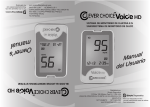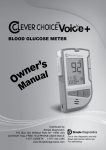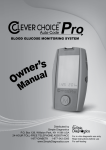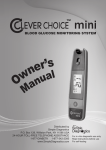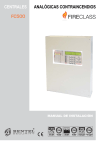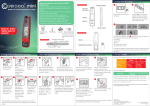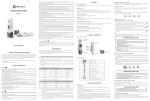Download Clever Choice HD Owner`s manual
Transcript
Distributed by Simple Diagnostics P.O.Box 128,Williston Park,NY 11596 USA 24-HOUR TOLL-FREE TELEPHONE ASSISTANCE 1-877-DIABETK 1-877-342-2385 www.SimpleDiagnostics.com For in vitro diagnostic use only Read instructions before use For self-testing HD Sistema de Vigilancia de la Glucosa en Sangre al Manu suario del U BLOOD GLUCOSE MONITORING SYSTEM HD Distributed por: Simple Diagnostics P.O.Box 128,Williston Park,NY 11596 USA LINEA DE ATENCION AL CLIENTE LAS 24-HORAS AL DIA (GRATUITO) 1-877-DIABETK 1-877-342-2385 www.SimpleDiagnostics.com Para uso diagnostico in-vitro Lea las instrucciones antes de utilizar Para autoanalisis DANGER - Misuse of this electrical device can cause electrocution, burns, fire and other HAZARDS. BEFORE YOU BEGIN……………………………………………5 Basic safety precautions should always be taken, including all those listed below. ABOUT YOUR SYSTEM…………………………………………6 Close supervision is necessary when equipment is used by, on, or near children, handicapped persons or invalids. ABOUT ALTERNATIVE SITE TESTING (AST)………………..7 INTRODUCTION TO THE SYSTEM……………………..6 CONTENTS OF THE KITS………………………………………9 1. Do not place the device in liquid, nor put it where it could fall into liquid. SETTING THE METER AND DELETING THE MEMORY......13 1. Setting the date and time…………………………..…..13 2. The following basic safety notice should always be taken. 2. Deleting the Memory…………………………………..14 3. Use the device only for the intended use described in this manual. 3. Setting the alarm……………………………………….14 THE TWO MEASURING MODES……………………………..15 4.Do not use adjunct which are not supplied by the producer. TESTING WITH BLOOD SAMPLE…………………………….16 5. Do not make the device come into contact with surfaces which are too hot to touch. 6.Do not use the device where aerosol sprays are being used. 7.Do not use the device if it is not working properly, or if it has been damaged. 8.Read all the manual, and practice the test, and then use the product to test your blood glucose. Do all quality control checks as directed and consult with a diabetes expert. Comparing Meter and Laboratory Results……………..22 CONTROL SOLUTION TEST………………………………….23 VIEWING RESULTS ON THE METER……………………….24 Recalling the Stored Test Results………………………24 Reading the Average of Blood Glucose Results………25 CARE AND STORAGE FOR YOUR SYSTEM………………26 Cleaning and Disinfection……………………………….26 METER SPECIFICATION………………………………………28 DISPLAY MESSAGE………………………………………..….31 BEFORE YOU BEGIN Installing the battery ■ The system is intended for use outside the body (in vitro diagnostic use). It is for single-patient use. It should be used only for testing glucose (sugar) and only with fresh capillary whole blood samples taken from the finger and the alternative sites including the palm, the forearm, the upper arm, the calf and the thigh. The system is intended for use at home. It should not be used for the diagnosis of diabetes or for the testing of newborns. 1. Open the battery cover on the back of meter. 2. If replacing the batteries, please remove the used batteries. 3. Insert 2 new (AAA) batteries with correct +/- direction. 4. Close the battery cover. Environment Protection – Waste electrical products should not be disposed of with household waste. Please recycle where facilities exist. Check with your local Authority or retailer for recycling advice. ■ The System is to be used by a single person and should not be shared. ■ The System is intended for self-testing outside the body (in vitro diagnostic use) by people with diabetes at home as an aid to monitor the effectiveness of diabetes control. The System should not be used for the diagnosis of or screening for diabetes, nor for neonatal use. Alternative site testing should be done only during steady – state times (when glucose is not changing rapidly). ■ The “CLEVER CHOICE” Test Strips are for use with the Blood Glucose Meter to quantitatively measure glucose in fresh capillary whole blood samples drawn from the fingertips, palm, forearm, upper arm, calf and thigh. ■ The CLEVER CHOICE control solutions is intended for use with the System, to check that the glucose meter and test strips are working properly and that you are doing the test correctly. These solutions contain a known range of glucose, as indicated on the strips vial bottles. AST in this system can be used only during steady-state blood glucose conditions described in the section of “About AST”. Test principle The test is based on the measurement of electrical current generated by the reaction of glucose with the reagent of the strip. The meter measures the current and displays the corresponding blood glucose level. The strength of the current produced by the reaction depends on the amount of glucose in the blood sample. ABOUT ALTERNATIVE SITE TESTING (AST) Important: There are limitations for doing AST. Please consult your healthcare professional before you do AST. What is AST ? Alternative site testing (AST) means that people use parts of the body other than the fingertips to check their blood glucose levels. This system allows you to test on the palm, the forearm,the upper arm, the calf,or the thigh with the equivalent results to fingertips testing. Fingertips feel pain more readily because they are full of nerve endings (receptors). At other body sites, since nerve endings are not so condensed, you will not feel as much pain as at the fingertip. Food , medication , illness, stress and exercise can affect blood glucose levels. Capillary blood at fingertip reflects these changes faster than capillary blood at other sites. Therefore when testing blood glucose during or immediately after meal, physical exercise, or any other event, take a blood sample from your finger only. You do AST in the following instances: ● In a pre-meal or fasting state (more than 2 hours since the last meal). ● Two hours or more after taking insulin. ● Two hours or more after exercising. ■ Alternative site testing(AST) should not be used to calibrate continuous glucose monitoring systems (CGMs). ■ Results from alternative site testing should not be used in insulin doses calculations. ● ● ● ● ● You think your blood glucose is low. You are unaware of hypoglycemia. You are testing for hyperglycemia. Your AST results do not match the way you feel. Your routine glucose results are often fluctuating. ■ ■ ■ ■ ■ ■ ■ ■ ■ A Meter Carry case Owner’s Manual Daily Log Book 1 2 3 4 Lancing Device(optional) Sterile Lancet(optional) Clever Choice Control solution (Optional) 7 5 6 9 8 10 11 ● The Lancing Device can be used for several times however the lancet should be changed after each use. ● Adjustable Automatic Lancing Device, sterile lancet and test strips are not included in the standard kit. ● There are three levels for the control solutions: low, normal and high available, please contact the place of purchase for more information. ● You can toll free service hotline: 1-877-342-2385, Available 24 hours a day/7 days a week, except USA Federal Holidays (Simple Diagnostics) to buy all of the items. 1 MEMORY SYMBOL Appears when you review the memory 2 MEASUREMENT UNIT Appears with the test result in mg/mL 3 BLOOD DROP SYMBOL Flashes when it is ready to apply the blood sample 4 TEST RESULT AREA Displays glucose results 5 TIME 6 DATE 7 TEST STRIP SYMBOL Appears when the meter is turned on If any items are missing from your kit or opened prior to use, please contact local customer services or place of purchase for assistance. 9 DAY AVERAGE Indicate that the displayed test result is an average value 8 CTL SYMBOL Appears when doing a control test and indicates that the result won't be stored in the memory. 11 ALARM SYMBO Appears when set the alarm 10 LOW BATTERY SYMBOL Appears when the battery power is low Blood Glucose Meter Test Strip Each strip can be used only once. The test strip consists of the following parts: 1 3 4 5 6 2 1 STRIP PORT Where you insert the test strip. The meter will turn on automatically 2 DATA PORT Located at the side, is for cable connection. 3 STRIP EJECTOR Slide forward to eject the test strip after test 4 LCD DISPLAY It guides you through the test using symbols and simple messages 5 “M” Button It is used to turn on the meter, enter the memory mode 6 “S” BUTTON It is used to set up the meter Absorbent Hole Apply a drop of blood here. The blood will be drawn in automatically. Confirmation window This is where you confirm if enough blood has been applied to the absorbent hole of the strip. Test Strip handle Hold this part to insert the strip into the slot. Contact bars Insert this end of the test strip into the meter. Push it in firmly until it will go no further. Attention! Test results might be wrong if the contact Bar is not fully inserted into the test slot. The front side of the test strip should face up when inserting the test strip. Frente Reverso Press “S” then “ 1. 1 Setting the Year Press and Hold “S” button for 3 seconds, until the last two digits of the year will flash on the screen (for example, “12” equals 2012).Press “M” button until the correct year appears. Press “S”. 1.2 Setting the month With the month flashing, press “M” until the correct month appears. Press “S”. ” “dEL " will display with flashing “no” or “yES”. OR Press “M” until “yES” flashing, Press the S button to delete ALL memory. The meter then displays “OK”, which means that the memory is deleted. If you don’t want to delete the memory, when “no” flashing, press the S button to skip this step. 1.3 Setting the day With the day flashing, Press “M” until the correct day appears. Press “S”. 1.4 Setting the hour With the hour flashing, Press “M” until the correct hour appears. Press “S”. 1.5 Setting the minute With the minute flashing, Press “M” until the correct minute appears. Press “S”. You may set up any or all of the alarms (1~4). When the meter is displaying “On” or “OFF”, press the “M” button to turn on or turn off the first alarm. Press the “S” button to select “On”, then to set the hour. When the hour is flashing, press the “M” button to add an hour. When the correct hour is set, press the “S” button to confirm and go to set the minutes. Press the “M” button to add one minute. When the correct minute is set, press the S button to confirm and go to the next alarm setting. You can switch between each mode by: 1. Start with the meter turned off. Insert a test strip to turn on the meter, the screen will display a flashing blood drop. 2. Press M to select General or CTL mode. If you want to turn off an alarm, press the S button to find the n” right alarm number and press the M button to change from “O to “OFF”. The date, time and memory deletion can ONLY be set in the setting mode. When the meter is in setting mode, if no button is pressed within 3 minutes, the meter will turn off. THE TWO MEASURING MODES The meter provides you with two modes for measuring, General and CTL. The CTL mode should be used when a control solution is being tested. See the table below. TESTING WITH BLOOD SAMPLE To reduce the chances of infection: ● Choose a clean, dry work surface. ● ● Always use a new and sterile lancet. Lancets are for single use only. ● ● Avoid getting lotion、oils、dirt or debris in or on the lancet and lancing device. Note: Before testing, please read the following steps thoroughly and carefully, please relax and do the test step by step. Simplifying or changing the test procedure may produce inaccurate results. CTL testing with the control solution Cocking Control A Clear Cap Release Button Lancet Holder Arrow Depth Indicator Adjustable Tip On the lancets and the lancing device. If your lancing device differs from the one shown here, please refer to the manufacturer’s manual to ensure proper usage. To reduce the chance of infection: ● Never share a lancet or the lancing device. ● Always use a new, sterile lancet. Lancets are for single use only. ● Avoid getting hand lotion, oils, dirt, or debris when handling the lancets. Screw off the cap of the lancing device. Insert a lancet into the lancet holder and push down firmly until it is fully in place. Twist the protective disk until it separates from the lancet. Replace the lancing device cap. Turn the cap until it is snug but not too tight. The adjustable tip offers 5 levels of skin penetration. Twist the adjustable tip in either direction until the number lines up with the arrow: 1-2 for soft or thin skin, 3 for average skin, 4-5 for thick or calloused skin. Slide the cocking control back until it clicks. If it does not click the device may have been cocked when the lancet was inserted. The lancing device is now ready for use. Set aside for later use. Stimulating blood perfusion by rubbing the puncture site prior to blood extraction has a significant influence on the glucose value obtained. Blood from a site that has not been rubbed exhibits a measurably different glucose concentration than blood from the finger. When the puncture site was rubbed prior to blood extraction, the difference was significantly reduced. Please follow the suggestions below before obtaining a drop of blood: ● Rub the puncture site for about 20 seconds before penetration. ● Use a clear cap while setting the lancing device for AST. Wash and dry your hands before starting. ● Select the puncture site either at the fingertips or another body part (please see section “Alternative Site Testing” (AST) on how to select the appropriate sites). ● Clean the puncture site using cotton moistened with 70% alcohol and let it air dry. Fingertip testing Hold the lancing device firmly against the side of your finger. Press the release button. You will hear a click, indicating that the puncture is complete. Performing a Blood Glucose Test Step 1. Wash hands with soap and warm water. Step 2. Remove a test strip from its vial. With clean, dry hands, you may touch the test strip anywhere on its surface. Do not bend, cut or modify the test strips in any way. Remove the test strip from the vial and use it instantly. Step 3. Insert the test strip into the meter's test port and the meter is turned on. The time and date appears on the screen. NOTE: Be sure to use CLEVER CHOICE test strips, other test strips may not produce accurate results. Blood from sites other than the fingertip A clear cap, together with the kit, makes it easier to get a drop of blood for AST. When you want to obtain blood from sites other than the finger, replace the lancing device cap with the clear cap. Turn the clear cap until it is snug but not too tight, and then slide the cocking control back until it clicks. Choose a different spot each time you test. Repeated punctures at the same spot may cause soreness and calluses. ■ Please consult your health care professional before you begin AST. ■ It is recommended to discard the first drop of blood as it might contain tissue fluid, which fmay a fect the test result. ■ Step 4 When the blood drop symbol flashes on the screen, you may select the appropriate measurement mode, for selecting the measurement mode of Control(CTL) or General, please refer to the “THE TWO MEASURING MODES” section. Step 5 Apply your blood to the absorbent hole of the test strip. Step 6 As soon as enough blood has filled the confirmation window of the test strip, you will hear a beep letting you know the test has begun. A countdown of 5 seconds starts. Note: make sure the confirmation window of the Test Strip is completely filled with your blood sample. Step 7 Your blood glucose level, along date and time appears on the display. Blood glucose results are automatically stored in the memory. The results obtained from this meter are plasma-calibrated. This helps you and your physician or other qualified healthcare provider to compare your meter results with laboratory tests. Reference to the instructions given by your physician or other qualified healthcare provider, do not deviate from these instructions on the basis of the result without first consulting your physician. Step 8 Eject the used test strip and remove the lancet. To eject the test strip, point the strip at a disposal container for sharp objects. The meter will switch itself off automatically after the test strip is ejected. Please wash hands thoroughly with soap and water after handling the meter, lancing device, or test strips. Reference value: Time of day People without diabetes Before breakfast (fasting) <100 mg/dL Two hours after meals <140 mg/dL Source: American Diabetes Association. Standards of Medical Care in Diabetes-2012.Diabetes Care 2012,35(Suppl.1)S11-S63. Please work with your doctor to determine a target range that works best for you. The meter provides you with whole blood equivalent results. The result you obtain from your meter may differ somewhat from your laboratory result due to normal variation. Meter results can be affected by factors and conditions that do not affect laboratory results in the same way. To make an accurate comparison between meter and laboratory results, follow the guidelines below. Before going to the lab: ■ Do a control solution test to make sure that the meter is working properly. ■ Fast for at least eight hours and then do comparison tests, if possible. ■ Take your meter with you to the lab. While staying at the lab: Make sure that the samples for both tests test are taken and tested within 15 minutes of each other. ■ Wash your hands and then obtain a blood sample ■ Never use your meter with blood that has been collected in a gray top test tube. ■ Use fresh capillary blood only. CONTROL SOLUTION TEST Material needed: ● Glucose Meter ● Clever Choice Test strips ● Clever Choice Control solution When to do a control solution test: ◆ When you open a new vial of test strips ◆ When you suspect that the meter or test strips are not working properly. ◆ If your blood glucose test results are not consistent with how you feel. ◆ After the test strips are exposed to extreme conditions. ◆ After dropping the meter. The control solution is to check that the meter and the test strips can work together as a system and work correctly. Step 1 Insert the test strip to turn on the meter. Insert the test strip into the meter. Wait for the meter to display the drop symbol. Step 2 You may press “M” button to select CTL mode, for selecting the CTL mode, please refer to the “THE TWO MEASURING MODES” section. Step 3 Apply the control solution Shake the control solution vial thoroughly before use. Squeeze out a drop and wipe it off, then squeeze another drop and place it on the tip of the vial cap. Hold the meter to move the absorbent hole of test strip so it touches the drop. Once the confirmation window fills completely, the meter will begin counting down. To avoid contaminating the control solution, do not directly apply control solution onto a strip. The result of the control solutions test appears on the display. The result will not be stored under CTL mode. The result of the control solutions test should be within the range printed on the test strip vial label. If the test results falls outside the specified range printed on test strip vial label, repeat the test. Results falling outside the specified range may be caused by: ■ Error in performing the test ■ Expired or contaminated Control Solution ■ Expired or contaminated Test Strip ■ Malfunction of your Meter If you continue to get control solution test results that fall outside of the range printed on the vial, the system may not be working properly, Do not use the meter. Please contact your customer support immediately. 24-hour toll free service hotline: 1-877-342-2385 Your meter stores the 500 most recent blood glucose test results with dates and times. It also provides 7-, 14-, 21-, 28-, 60- and 90 -day averages of your blood glucose test results. Note: The control solution readings are not included in the average of your results. 1.Start with the meter off, press the button to turn on the meter.The “ ” symbol will flash with the time and date displayed on the screen. CARE AND STORAGE FOR YOUR SYSTEM 2.Press again, the most recent test results with date and time will display. Press “M” once more and the next most recent test results will appear. Each time you press and release “M”, the meter will recall up to your last 500 test results in order. Press the “S” to turn off the meter. When the memory is full, the oldest result is dropped and the newest result is added. Reading the Average of Blood Glucose Results When the meter is off, press and hold the “M” button until the DAY AVG flashing, release button then 7-day average results appear with “n024” (means 24 records to be averaged) on the screen. Press the “M” button to review the 14-, 21-,28-, 60- and 90-day general averages. Press the S button to turn off the meter. Note: The control solution readings are not included in the average of your results. ◆ Handle the meter with care. Dropping or throwing the meter may cause damage to the device. ◆ Don't expose the Blood Glucose Monitoring System, Test strip, and Control Solution, to extreme conditions, such as high humidity, heat, freezing cold or dust. The storage conditions for the test strips are 39 86 , Humidity<85%RH. Storage conditions for the meter are -40 131 , Humidity<80%RH. ◆ Always wash your hands with soap and water and rinse and dry completely before handling the Blood Glucose Monitoring system and Test strip. ◆ Use CaviWipes (see below) to clean the Blood Glucose Monit oring System. ◆ Discard the used lancet into a container for sharp objects. Cleaning and Disinfection The cleaning and disinfection is absolutely necessary for the test procedure, because cleaning can insure the meter works well (for example, display will be clear to see after cleaning); and disinfection can avoid the infection to you or to the other people, and the cross-infection. We strongly warn that the device should be cleaned and disinfected following use on every patient. And we suggest you use the following product: CaviWipes (EPA registration number : 46781-8). You can purchase this product according to the following information: visit the web site: www.metrex.com or contact Metrex at 800-841-1428 for product or technical information. CaviWipes are also available at www.amazon. com or via a Google search. The meter for single-patient use and the lancing devices may be cleaned 5-6 times per day (Test 5-6 times every day), so the meter will be cleaned and disinfect about 11000 cycles that include cleanings plus disinfections (1 cycle = 1 cleaning + 1 disinfection) during its 5 years life cycle. 1. Before the test, the user should clean and wash hands. If you are a caregiver, (not the patient), the please use disposable gloves. 2. After test, take one wipe to clean the meter’s housing, buttons, lens, mark, usb cover and support block, including its front and back for 10 seconds for cleaning until there is no soil on the surface. Then disinfect the meter’s housing, buttons, lens, mark, usb cover and support block use another wipe for 2 min, keep the surface wet for 2 min. 3. Take off the glove; discard carefully according to your healthcare provider’s instruction. Note: 1. Each disinfection step requires a pre-cleaning step. 2. If the meter is being operated by a second person who is providing testing assistance to the user, the meter and lancing device shall be cleaned and disinfected first. 3. The users should wash hands thoroughly with soap and water after handling the meter, lancing device, or test strips. 4. If you have any questions you can dial the number 1-877-342-2385 5. Please refer to the following linkage for detail information: “FDA Public Health Notification: Use of Fingerstick Devices on More than One Person Poses Risk for Transmitting Bloodborne Pathogens: Initial Communication” (2010) http://www.fda.gov/MedicalDevices/Safety/AlertsandNotices/ ucm224025.htm “CDC Clinical Reminder: Use of Fingerstick Devices on More than One Person Poses Risk for Transmitting Bloodborne Pathogens” (2010) http://www.cdc.gov/injectionsafety/Fingerstick -DevicesBGM.html 6. Table: A list of the signs of potential deterioration (Physical and in performance) What do you see? The buttons do not work The device does not work What to do? Stop using and contact local customer services or place of purchase for assistance, or toll free service hotline: 1-877-342-2385 Stop using and contact local customer services or place of purchase for assistance, or toll free service hotline: 1-877-342-2385 Discoloration of the buttons , meter casing or lancing device Stop using and contact local customer services or place of purchase for assistance, or toll free service hotline: 1-877-342-2385 Corrosion, crazing, embrittlement, cracking of the buttons, meter casing, display or lancing device Stop using and contact local customer services or place of purchase for assistance, or toll free service hotline: 1-877-342-2385 Cloudiness of the lens Stop using and contact local customer services or place of purchase for assistance, or toll free service hotline: 1-877-342-2385 1. Model: CLEVER CHOICE HD (with “Clever Choice” test strip and Clever Choice control solution) 2. Machine size: 88mm (L)×55mm (W)×26mm(H) 3. Weight: 45g (excluding batteries) 4. Measuring method: Amperometric technology using glucose oxidase 28 5. Result range: 20 mg/dL ~600 mg/dL(1.1 mmol/L ~33.3mmol/L) 6. Glucose Units: Either mg/dL or mmol/L (USA version preset mg/dL only) 7. Memory : 500 blood glucose tests 8. Display: LCD display with backlight 9. Power source: DC 3V (AAA×2 alkaline batteries) 10. Battery Life: Approx. 500 normal tests 11. Storage Condition: Blood glucose Monitoring system (meter and test strips): 39 86 , Humidity<80%RH. 12. Storage Condition (meter): -40 131 , Humidity<80%RH 13. Operating conditions: 50 104 , Humidity:25%~80%RH 14. Blood Source: Fresh capillary whole blood 15. Blood Volume: Minimum 0.7 micro liter. 16. Use life: five years NOTE: Factors affecting the life of the meter The factor The indication Do this: The aging of the strip connector The meter cannot be turned on when Inserting the test strip several times. please contact local customer services or place of purchase for assistance, or toll free service hotline: 1-877-342-2385 The clouding of the lens The aging of the electronic components 29 The content displayed please contact local cuson the lens cannot be tomer services or place of purchase for assistance, recognized clearly. or toll free service hotline: 1-877-342-2385 The results are not accurate when the test strips are in normal mode. please contact local customer services or place of purchase for assistance, or toll free service hotline: 1-877-342-2385 ※ The blood Monitoring System is not intended for use on neonates. ※ The blood Monitoring System is not intended for use on artery blood, neonates’ serum and plasma. ※ The Blood Glucose Meter should be used with “CLEVER CHOICE” test strip. ※ The system can be used up to an altitude of 10744 feet. ※ The following substances at levels greater than normal or therapeutic levels may cause significant interference (affect the result by greater than 10%) resulting in an inaccurate result: ascorbic acid, uric acid, hemoglobin,acetaminophen, Dopamine, L-dopa, L-dopa and Tolbutamide etc. These substances do not affect test results in normal concentration but may affect test results in high concentration. Do not use haemolysis sample, icterus sample or high lipemia samples. ※ The following compounds, when determined to in excess of their limitation, may produce inaccurate results: Compound Limitation Ascorbic acid >2mg/dL Uric acid >10mg/dL Acetaminophen >5mg/dL Bilirubin >15mg/dL Dopamine >0.03mg/dL L-dopa >0.45mg/dL Methyldopa >0.75mg/dL Tolbutamide >24mg/dL Triglycerides >2000mg/dL Hemoglobin >250mg/dL 30 ※ Patients undergoing oxygen therapy may yield falsely lower results. ※ Not for use for patients in a hyperglycemic-hyperosmolar state, with or without ketosis. ※ Not for use on critically ill patients. ※ Not to be used for patients who are dehydrated, hypertensive, hypotensive or in shock. ※ Very low (less than 20%) or very high (more than 60%) red blood cell count (hematocrit) can lead to incorrect test results. If you do not know your hemarocrit level, please consult your health care provider. MESSAGE ACTION WHAT IT MEANS Blood glucose level is The message indicates very low blood sugar. You lower than 20mg/dl should consult with your (1.1mmol/L) healthcare professional. Blood glucose level is This indicates sever higher than 600 mg/dl hyperglycemia (high blood glucose). (33.3mmol/L) You should seek immediate medical assistance. Meter is ready to test Please place a drop of control solution under control solution onto the test well of test strip. the CTL state. Battery power is low. 31 Please change the battery. MESSAGE WH AT IT MEANS Use a used test strip. ACTION Please use a new strip and re-test. Error massage indicates Try again with a new that you may remove the test strip. strip after applying blood to the absorbent hole. Problem with the meter. Re-test with a new test strip. If the problem is still unsolved, please call the Customer Care Line for help. Environmental temperature is lower than 10 (50 ) or higher than 40 (104 ) Please test at an environmental temperature Display remains 1. Battery may be 1.Install the Battery blank after the installed improperly. correctly. test strip has 2. Battery power is 2.Replace with new been inserted too low for use. Battery. into the Meter. 3. Too much time has 3.Reinsert the Test passed between Strip into the inserting the Test Meter. Strip and performing the test. 32 4. Test Strip has not been fully inserted into the Meter. 4. Reinsert the Test Strip into the Meter. Test results 1. Not enough sample 1. Redo test with new test strip and make in the Test Strip. are incon sure that enough 2. Test Strip or Control sistent or Solution has expired. sample has been Control added. Solution test 3. Test Strip has been 2. Redo test with new damaged due to results are test strip. heat or humidity so not within that sample cannot 3. Perform a Control the specified Solution test using a be applied or the range. new Test Strip. If speed of applying results are still out of sample is too slow. range, replace with 4. System is not pernew vial of Test Strips. forming due to the environment being 4. Bring System to a room temperature above or below environment and room temperature. wait approximately 30 minutes before performing a new test. The Meter countdown did not start. 33 Test Strip has not been inserted correctly. Use a new Test Strip and redo the test. 611-42500A-001 VER 1.1


















